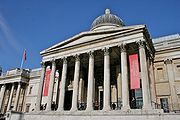
File:Mr and Mrs William Hallett.jpg

| |
This is a file from the Wikimedia Commons. Information from its description page there is shown below.
Commons is a freely licensed media file repository. You can help. |
Summary
| Artist |
|
||||||||||||||||||||
| Title | Mr and Mrs William Hallett (“The Morning Walk”) | ||||||||||||||||||||
| Date | 1785 | ||||||||||||||||||||
| Medium | oil on canvas | ||||||||||||||||||||
| Dimensions | 236 × 179 cm (92.9 × 70.5 in) | ||||||||||||||||||||
| Current location |
|
||||||||||||||||||||
| Source/Photographer | From en:Image:Mr and Mrs William Hallett.jpg | ||||||||||||||||||||
Licensing
The official position taken by the Wikimedia Foundation is that "faithful reproductions of two-dimensional public domain works of art are public domain, and that claims to the contrary represent an assault on the very concept of a public domain". For details, see Commons:When to use the PD-Art tag. |
File usage
Metadata
| JPEG file comment | GAINSBOROUGH, Thomas (b. 1727, Sudbury, d. 1788, London) Mr and Mrs William Hallett ('The Morning Walk') 1785 Oil on canvas, 236 x 179 cm National Gallery, London Instinctive, unpompous, drawn to music and the theatre more than to literature or history, and to nature more than to anything, Gainsborough continues to enchant us, as the serious Reynolds seldom can. Suffolk-born, like Constable, he also became, within his means and times, a 'natural painter' - albeit of a very different kind. Although he said he wished nothing more than 'to take my Viol de Gamba and walk off to some sweet Village where I can paint Landskips', his feeling for nature encompassed much more than landscape. Children and animals, women and men, everything that dances, shimmers, breathes, whispers or sings, look natural in Gainsborough's enchanted world, so that 'nature' comes to encompass silks and gauzes, ostrich feathers and powdered hair as much as woods and ponds and butterflies. But this rapturous manner of painting, in which all parts of a canvas were worked on together with a flickering brush, only appears in mature works, such as this famous and splendid picture. In his early years in Sudbury, after his training in London restoring Dutch landscapes and working with a French engraver, Gainsborough's finish was less free. After moving to the resort town of Bath in about 1759, he found a metropolitan clientele, and discovered Van Dyck in country-house collections. Both were to be decisive, and the effects are best judged in his portraits of women sitters, on the scale of life, in which elegance and ease of manner combine with a new, more tender colour range and a loosening of paint texture. In 1774 he moved permanently to London, where he built up a great portrait practice, but also began to paint imaginative 'fancy pictures' inspired by Murillo. He never aspired to 'history painting' in the Grand Manner. His poetry resides mainly in his brush, not in compositional inventiveness. It was surely Gainsborough's own inclination, however, to interpret a formal marriage portrait, for which the sitters probably sat separately, as a parkland promenade. William Hallett was 21 and his wife Elizabeth, née Stephen, 20 when they solemnly linked arms to walk in step together through life. A Spitz dog paces at their side, right foot forward like theirs, as pale and fluffy as Mrs Hallet is pale and gauzy. Being only a dog with no sense of occasion he pants joyfully hoping for attention. The parkland is a painted backdrop, like those of Victorian photographers, yet it provides a pretext for depicting urban sitters in urban finery as if in the dappled light of a world fresh with dew.
Author: GAINSBOROUGH, Thomas Title: Mr and Mrs William Hallett ('The Morning Walk') Time-line: 1751-1800 School: English Form: painting Type: portrait |
|---|
Background information
Schools Wikipedia was created by children's charity SOS Children's Villages. SOS Children helps those who have nothing and no one, giving them back the famly they have lost and bringing them the very best opportunities for a happy, healthy future. Have you thought about sponsoring a child?



